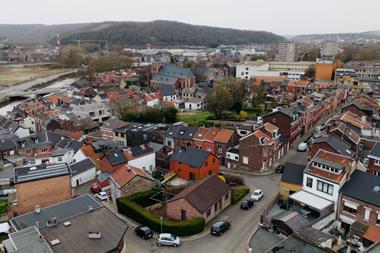
Much of the talk at a surprisingly busy Expo Real trade fair this year could be filed under the cliched label of “cautious optimism”. Real estate markets had turned a corner, people agreed. Falling interest rates and stabilising asset values paved the way for a recovery in transaction volumes in 2024.
But mixed in with the relative positivity of the conversations in Munich was an uncertainty over how the long-awaited real estate recovery would be different this time. There seemed to be a recognition that the asset class was not going to simply return to the booming years of the lower-for-longer era.
The coming recovery will usher in a “new chapter of how to invest”, said André Zücker, co-CEO of German real assets fund manager KGAL. “It will not be the same old world.”
Aldo Mazzocco, CEO of Generali Real Estate, said real estate was “at the end of the negative cycle”, but was concerned that the industry expected the asset class to return to the exuberance of the recent period of low interest rates. Yes, the market “suffered a crisis” in the form of COVID-19 and then rising inflation, but “the problem is we were in a bubble before, so in the end this is normalisation”, he said.
“I think we’re at the beginning of a recovery in terms of capital flows back into space,” said Randy Giraldo, head of Europe at Nuveen Real Estate. “Therefore I feel pretty good about ‘25, ‘26 in terms of capital flows and pricing,” But, he added, the market was still suffering from a “hangover” of the injection of liquidity by central banks following the COVID-19 pandemic.
The real estate bull market that followed the 2008 global financial crisis – fuelled in large part by low interest rates – had already become long in the tooth in the years and months leading up to COVID-19 in early 2020. “Growth was slowing down materially, debt levels were accumulating, and then we had COVID,” Giraldo said. “COVID was this abrupt end of the cycle – and then a continuation of the cycle with injected liquidity.” He said: “We’ve been experiencing the hangover of all that excess liquidity, so it’s tough to gauge where we actually are in the cycle when you’ve had a cycle inside of a cycle.”
Meanwhile, institutional real estate portfolios have also evolved over the past decade so that they are less heavily weighted to offices and have more diversified exposures to alternative sectors. Despite this, it is still difficult to detach the fortunes of the wider asset class from the dymamics playing out in the office sector specifically.
Everyone, it seems, has been focusing on “beds and sheds” – or residential and logistics – in 2023, but the real bellwether for a full real estate recovery seems to be whether investors will be brave enough to return to the office market in full force in 2024.
KGAL recently made office acquisitions in Germany and Austria after three years of avoiding new investments in the sector. “We’re now coming back to the table for offices,” said Zücker. “We think now the risk-return profile is really good.”
Giraldo said: “I think we’re at the beginning of a recovery in terms of capital flows back into space.” But, he suggested, a big question is, “when will the big move start to occur in office?” He said: “I think large pools of capital will eventually move in at scale, likely through privatisation of public companies in the US. Probably that will create an all-clear signal for the asset class.”
But the bifurcation playing out within office markets is leading investors to question whether they can be analysed as a single sector. “There is no such sector as offices – to me, it just doesn’t exist anymore,” said John O’Driscoll, global co-head of real estate at AXA IM Alts. “It’s just a range of different sub-segments that will perform quite differently.”
He said: “Assets that are in great locations, leased well, seeing some [rental] growth, will start to trade and we’ll get more established benchmarks. And then anything outside of that segment will be an individualised story. It’ll be a repositioning story, it’ll be a yield discount story, it’ll be some something different.”
Real estate equity back in the game?
The biggest change in recent months, O’Driscoll added, was the shifting dynamics between real estate equity and debt, as interest rates have started to come down. “It’s always been a big business for us, but in terms of finding new opportunities in the debt space that has been the big story of 2023 and probably early 2024,” he said.
“What’s changed a lot over the last three or four months is the discussion around equity strategies. If you go back to October 2023, the pitch on real estate equity was hard because we were still at a cycle of valuation decline, rates were really at a peak in October 2023… it was easier to talk about debt because you were benefiting from lower valuations, higher absolute returns, good spreads, a banking market that was less comfortable above 50%.”
But the recent stabilisation of real estate valuations mean that real estate equity is back on a more even footing versus debt and this will “manifest into transaction volume”, O’Driscoll said. ”By the time you really see the outcome of this more productive debate around debt versus equity, you’re going to see it in Q1, Q2 next year transaction volumes. You will certainly will see it in Q3.”
Kieren Farrelly, global CIO of real estate at Schroders Capital, said: “We’re certainly of a view that, with some of the value falls and adjustments we’ve seen in a number of markets and sectors, that it’s a great window for investors to access the long-term benefits of the asset class.”
Farrelly, who a year ago wrote about the “sequential real estate opportunity on the horizon”, said: “Markets like the UK in particular [and] industrials across the region we think are offering immediate and compelling value. And what do we mean by that? Prospective returns that would be materially above what we think investors should be expecting of a meaningful order of magnitude.” He added: “We’ve talked about it in the past being on the horizon, but our view would now be its live.”
To read the latest IPE Real Assets magazine click here.























